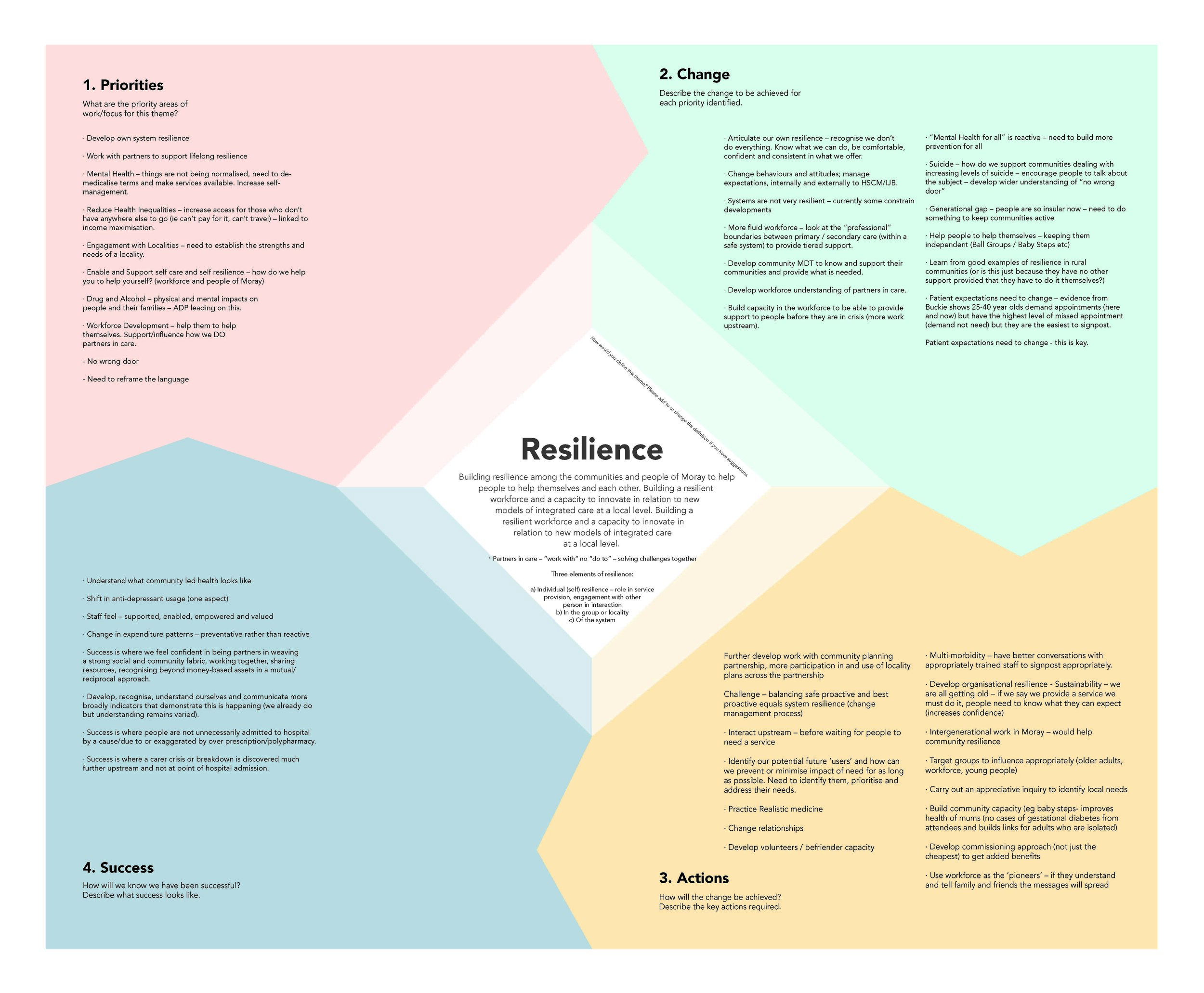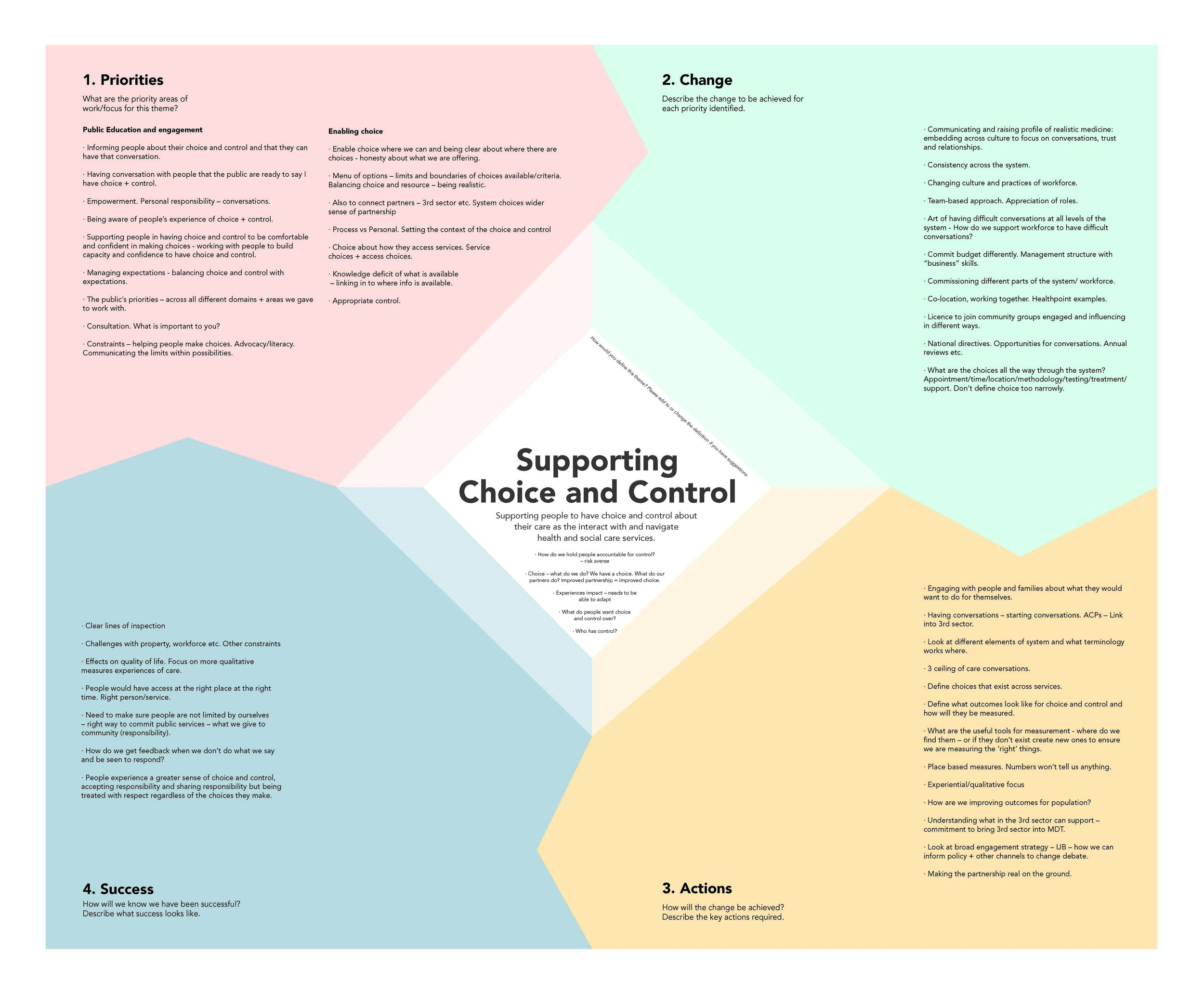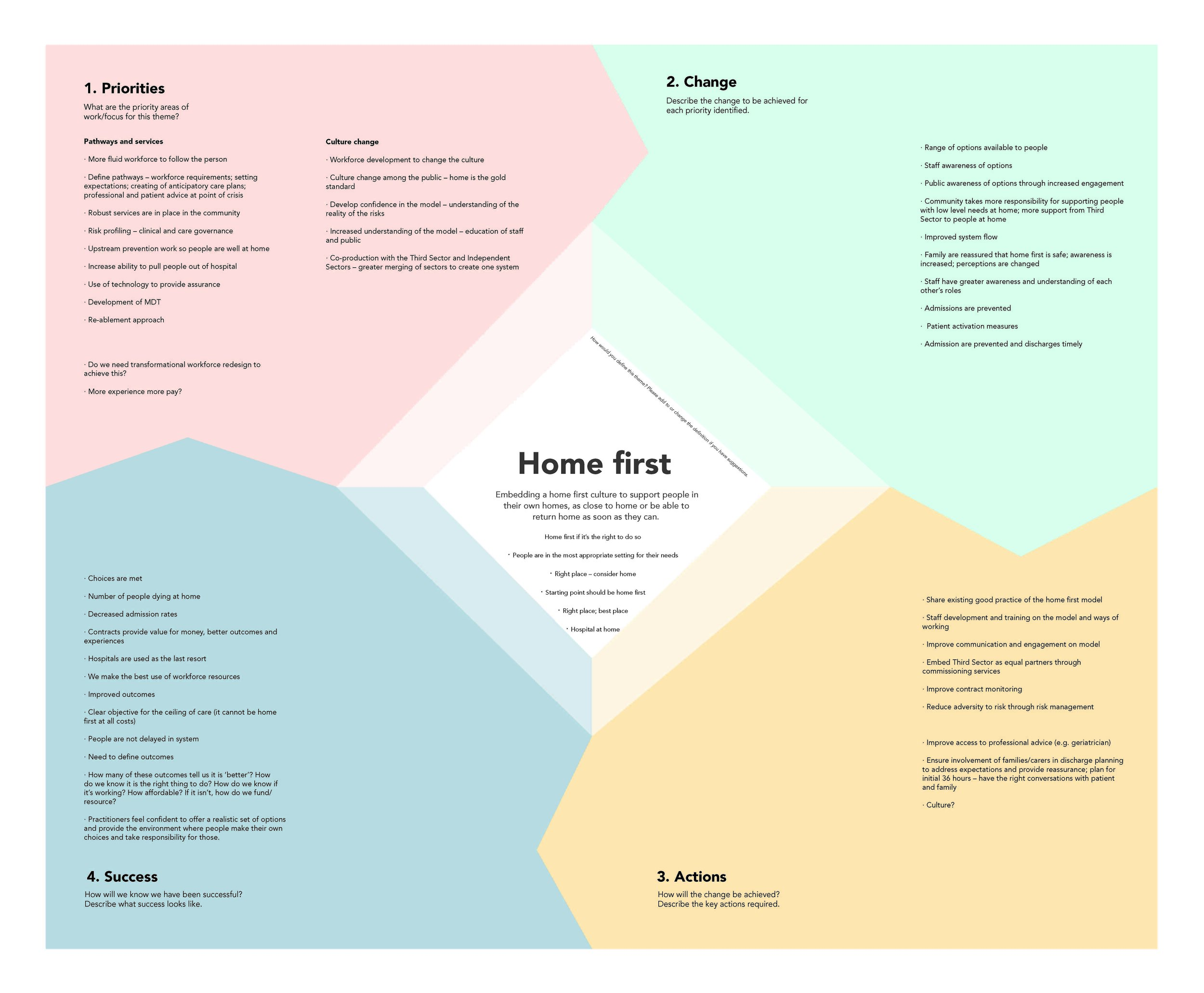Building a shared strategic vision for health and social care integration in Moray
Introduction
Visual: Process timeline of building a shared understanding and vision
There are many challenges and layers of complexity that exist across Scotland in relation to the integration of health and social care. Communication, silos and changes in culture are key areas that require attention and action in order to support building a shared understanding and direction of what integration means for each health and social care partnership.
As part of the collaboration between The Innovation School and Health and Social Care Moray, we supported the early stage development of the 2019 strategic vision. Through a number of workshops, The Innovation School facilitated a process to enable a ‘safe space’ for dialogue around building the strategic vision towards identifying key priority areas and actions.
Prior to the workshops, initial conversations with members of the leadership team in Moray highlighted a number of recurring challenges related to developing a shared vision across the different organisations involved in integration. These included: differences across localities, collecting evidence and demonstrating impact, capturing and sharing learning and the need for co-design, openness and ‘letting go’.
Workshop 1: Building a shared vision and understanding
Image credit: Sean Fegan
The first workshop took place in September 2018 at The Glasgow School of Art Highlands and Islands Campus. The workshop participants were members of the leadership and senior management team providing health and social care in Moray. The workshop aimed to develop a shared understanding of the vision for integration in Moray to inform the development of the strategy. Participants were firstly asked to introduce themselves and their role by sharing a key challenge, asset, vision for integration and aspiration for impact related to their current role using a laser cut wooden tool. The discussion during this activity focused around the need for improved communication and developing principles for working together to understand, trust and have confidence in each other. The table below provides a summary of the thematic challenges, assets, vision and impact shared by participants.
The challenge pieces of the tool were then clustered to form key themes which were taken forward as areas of focus for the next activity.
Image credit: Sean Fegan
Four key themes emerged which participants chose to focus on:
Coordination
Culture
Expectations and demand
Workforce recruitment and sustainability
Participants formed smaller groups around each key theme and were given a visual canvas to help structure and capture the group discussion for the second activity. The canvas was structured to allow participants to further discuss and describe the challenge of the chosen theme and share their aspirations and outcomes they would like to achieve in relation to the challenge. Then they had to respond to four key questions that focused on supporting people: to self-manage and self-care, have high value interactions across the system, to navigate the system ensuring consistency and integration of services around needs, through integrated ways of working. Finally, each group was asked to capture ‘drivers’ and ‘impacts’ for the theme on arrow cards.
Download the visual canvas.
Findings
Theme 1: Co-ordination
Many challenges exist in relation to coordination given the complexity of the system e.g. IT, cultural silos, organisational challenges, implementation plans, strategy overload, lack of prioritisation, lack of micro-coordination, communication, trust and transparency, and confidence that the planned priorities are the ones to work on.
The group highlighted that many strategies already exist across the system, however many do not reach the point of implementation. There is a need to consider how these areas are prioritised and to be aware of what happens at the micro, ground level, as well as an awareness of the macro context.
The need to clarify and trust the planning process was discussed as well as sharing information about patients. Emerging questions about the role of coordination were discussed, e.g., what is coordinated and what is required in order to coordinate services? This is necessary when building alliances to co-design future service provision.
Developing a shared language, specifically in relation to ‘clinical’ areas was discussed in order to understand what is meant by ‘clinical’. A key aspiration highlighted by the group was the need to work towards the same goals across teams and systems and also support feedback and learning opportunities related to satisfaction.
The group also highlighted the need to recognise the pressures of facing people in other roles and parts of the system with implications around realistic expectations for what is achievable. This is also linked to developing knowledge and awareness across all parts of the system. The need for managers to be connected ‘to the ground’ was also proposed.
Theme 2: Culture
Culture is always changing and in a state of flux and requires trust and stability in order to achieve cultural change. The group highlighted the challenges of instability, budget constraints, pace of change and issues of trust, confidence and uncertainty which all impact on creating a culture of ownership across the system. Identifying learning opportunities and having an understanding of ‘who does what’ across the system were highlighted as ways in which to begin addressing the challenges of culture. The Moray Alliance was identified as a mechanism through which this could be supported.
Other challenges raised related to the language and labels which make things difficult such as the ‘Moray Council Directory’ and also the different language used in relation to terms like primary and secondary care. The group also recognised the need to understand what gets in the way of care structures being set up, discussing capacity and the need to legitimise this.
The group highlighted the need to measure and evidence ‘what does good look like?’ and explore this across localities. All of this requires collegiate accountability. This led the discussion among the wider group to focus on what needs need to be addressed before looking at each locality area.
Finally, the group discussed the way in which a culture, either envisioned or emerging, looks like and how to create the conditions for this. In parallel, this links to considering decision-making and the way in which additional demands are managed. The group highlighted the need to articulate the vision and then consider the behaviours and actions, with a particular focus on developing a shared vision with clinical staff. The discussion around “one system” where the individual local systems are clearly “branded” to communicate they are part of this one system, highlighted implications for creating a strong identity and recognising a shared culture in terms of working towards the same ethos. Clarification and leadership were highlighted as key to supporting shared culture and identity.
Theme 3: Expectations and demand
The group discussed the need to identify who and what the drivers are in terms of demand and what the expectations are from all the different ‘actors’ involved. Marketing and crafting the ‘message’ around health and social care in Moray was identified important in relation to managing expectations and demand. The need to develop ‘realistic care’ related to Realistic Medicine was also highlighted, asking the right questions to ensure people receive care in the right place at the right time.
The group highlighted that the challenge of primary and secondary care are not universally understood or used across systems. The need to remove boundaries and reduce silos was highlighted as a way to mitigate this.
Theme 4: Workforce
Discussions around workforce focused on the need to consider the current workforce in terms of staff across the system and to understand what can be done to support staff development (appraisals). The importance of finding ways to remove barriers was highlighted along with the role that culture plays in this. IT systems continue to be a challenge and the group suggested that a separate team is required to work on this issue to remove pressure from other staff and release time.
Finally, the group highlighted the need to consider how transformation is framed in order to deliver change and make sure everyone is invested and recognises the difference it will make to their role. In addition, having an awareness and recognising how change impacts the working practices for others was also highlighted as a key consideration. Therefore, it is important to look at how change is delivered holistically across the system in order to understand the impact of change on all parts.
Developing a strategic framework for integration in Moray
As part of the thematic group activities, participants were also asked to consider strategic aspects of health and social care for care provision in Moray. These related to supporting self-management and high value interactions for the people of Moray, and integrated ways of working and navigation to support a collective vision and consistency across the system. The findings of the discussion are summarised in the table below.
Recurring themes
1% design: refine and iterate
Many of the groups highlighted the need to 'start somewhere' and begin to rapidly prototype new ways of working that embrace the shared vision. This could support a culture of innovation to emerge and open up opportunities to support change among the workforce. It also provides a way to ‘fail fast’, capturing learning for what works well in the early stages and refine the direction for change. Embedding an ethos of ‘co-design’ and exploring opportunities underpinned by lived experience could also lead to greater success in implementation and adoption of change.
Creating a common language and shared understanding
There was a need to develop a shared language around integration in order to achieve the vision and a “one system” approach. This requires meaningful engagement and fluid communication across all levels of the system in order to build a shared understanding of the ambitions and strategic priorities. This also supports the development of the Moray ‘brand’ and identity.
Aligned to this, the groups highlighted a need to build an understanding of 'who does what' across the system in order to recognise the pressures faced by different areas of the system and also to support person-centred care.
Baseline informed priorities
In relation to understanding coordination and challenges there was a need to 'take stock' and generate a baseline of current services and offerings. From this, it would be possible to determine priority areas and build future models of care around key challenge areas in order to address needs and develop more responsive provision.
Workshop 2: Mapping the current project landscape
The second workshop took place in April 2019 and aimed to build a picture of the integration and transformation landscape in Moray, identifying current projects, relationships and linkages across projects and their contribution to the strategic vision.
The workshop involved mapping existing and planned projects to identify areas for future work, key learning and sharing of good practice opportunities, and current and future change and impact across services. The workshop also supported participants to identify the relationship between the draft themes for the strategic plan and their relevance to the projects for development of implementation and service plans.
The project landscape was translated into a visual map to illustrate the relationships and themes across projects and key enablers, which can be seen below.
Workshop 3: Scoping the Health and Social Care strategy
The visual project landscape map was refined during a third workshop session in May 2019 where participants had the opportunity to review the information presented and identify any gaps. The workshop also aimed to support participants to consider the learnings and themes related to these projects to inform the strategic vision.
The second part of the workshop focused on supporting the discussion around key areas for the development of the strategy. Participants were guided through a process to identify the local and national drivers which inform the strategy, the challenges the strategy seeks to respond to, the assets supporting the strategy and the key outcomes and impacts the strategy seeks to achieve.
The findings of the workshop were translated into a strategy canvas. The iterations of the canvas over the course of the workshops can be viewed here. The strategy canvas provides a visual tool to support Health and Social Care Moray to have wider conversations around the strategy, to promote dialogue among their partners and can also be used as a tool to engage the local community.
WorksHop 4: refining the collective strategy vision and outcomes
Using the strategy development canvas (the refined version can be seen in the visual below), participants were supported towards refining the key outcomes of the strategy building on the projects identified during workshops 2 and 3. The group explored and identified key outcomes, impacts, vision and priority areas of work that will be undertaken to achieve the strategy aims. The workshop resulted in a revised version of the strategy canvas to be used as a tool to guide the remaining strategy development work.
workshop 5: ‘PARTNERS IN CARE’ - refining PRIORITIES AND ACTIONS FOR THE STRATEGY
The final workshop shared the strategy development to date with a wider group of participants and aimed to further define the themes, identify priorities and key actions and describe what success would look like in relation to each theme. Participants worked in three groups around each theme area: ‘Resilience’, ‘Supporting choice and control’ and ‘Home first’; and then rotated around each group so that all participants could review and contribute to each theme. The insights gathered during the workshop were synthesised into a visual per theme to communicate the priorities, change, actions and success, to support the remaining strategy development process.
For more information contact:
Dr Tara French | t.french@gsa.ac.uk











